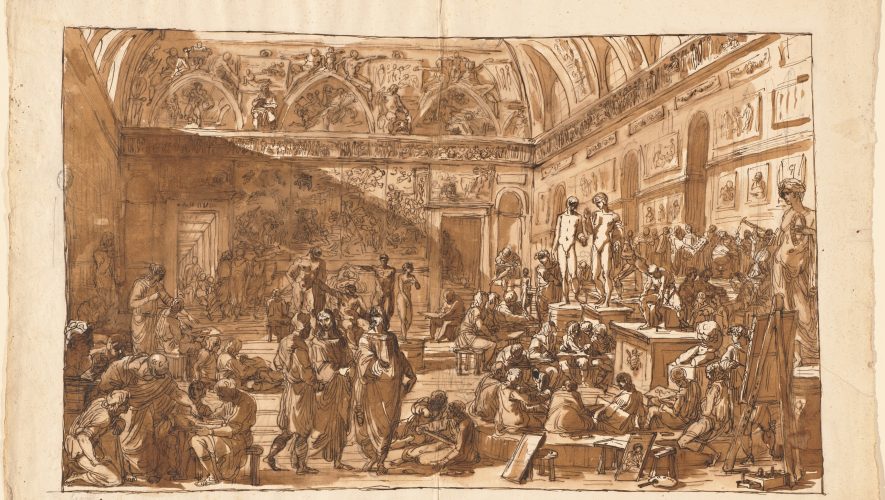Something is wrong with our university system. Many young Americans decide against enrolling in or even applying to universities and community colleges. College enrollment has declined every year for the past decade, and there are one million fewer students in college today than there were before the COVID-19 pandemic. Credentialism and the college experience don’t seem attractive enough for today’s youth to justify the cost. Although many jobs require college degrees, top CEOs like Tesla’s Elon Musk and Apple’s Tim Cook have publicly questioned the value of a university education and hire many uncredentialed candidates. Opportunities like the Thiel Fellowship, which offers driven young minds $100,000 to skip or drop out of college and pursue their own ideas instead, further threaten the university. All the while, tuition costs continue to rise quickly. To attract young people and provide compelling value, universities need to reimagine themselves in light of their original purpose: education.
This resurrected purpose, education, focuses on meeting the needs of university students. One of the most common reasons students choose a specific college is because “[that] college’s graduates get good jobs.” Students expect higher education to improve their employment prospects, enabling them to provide for their physical needs. Students also seek to meet their immaterial needs such as friendship, virtue, and fulfillment. Education consists of two components that meet these different needs: vocational education, which focuses on job skills and problem solving, and liberal education, which focuses on critical thinking and cultivating the mind. These components can easily coexist in many settings. The natural sciences, for example, often combine research (a vocational aim) with ethical considerations and epistemological questions (liberal aims). However, different factors help and hinder these two domains of education. To determine how universities should refashion themselves in favor of education, we must scrutinize their current actions in light of both vocational and liberal education’s purposes.
Vocational Education
Students often engage in vocational education through their classwork, involvement in professional organizations, research experiences, and co-operative education programs. Science, technology, engineering, and math (STEM) majors are associated with vocational education because STEM classes develop student’s research and problem-solving skills, but subjects like accounting and technical writing also have a strong vocational slant owing to their real-world focus.
Yet even as colleges teach vocational skills so that their students can enter high-earning jobs, choosing college is so expensive that it often financially disadvantages both parents and students. Forty-three million Americans hold a combined $1.6 trillion of outstanding student loan debt, averaging roughly thirty-seven thousand dollars of debt per borrower. The average amount of debt with which a student graduates has quadrupled since 1970 (adjusting for inflation). This trend—in tandem with rising tuition costs—makes collegiate vocational education inefficient.
To counter these rising tuition and debt levels, universities should consider doing away with onerous major requirements, strict prerequisite chains, and university-wide minimum credit requirements. Prerequisite chains supposedly guarantee understanding and student success, but restrictive prerequisite requirements often force students to repeat classes they took in high school, increasing their tuition costs. Universities should supplement these strict requirements with placement tests that can serve the same purpose at a lower average cost.
Further, poor coordination between the private sector and higher education creates a gap between degree plans and in-demand job skills. This skills mismatch means that strict university program requirements are not only expensive but also frequently ineffective, leaving many college graduates underemployed. Further, this skills mismatch has a strong negative correlation with national productivity. As technology progresses and the economy morphs, universities need to constantly adjust their vocational curricula to match the current and future needs of the economy. The current system of inflexible degree pathways and university minimum credit requirements serves to guarantee a university revenue while failing to further education. Instead of providing for student needs, these systems raise the cost of college, making it a luxury that only the wealthy can enjoy.
Liberal Education
In contrast to vocational education’s concern for physical needs and skills, the goal of a liberal education is the cultivation of the mind. This cultivation is the process of becoming humble, recognizing one’s lack of knowledge, and then bold in seeking truth carefully. Liberal education aims at enlightenment, which Immanuel Kant describes as an individual’s freedom to use their powers of reason publicly. Universities offer liberal education through literature courses, seminar classes and discussion groups, and the study of liberal arts. These opportunities also help prepare students for work by teaching them soft skills such as critical thinking and problem solving.
In a vocational context, coursework often focuses on practical skills and techniques with tangible metrics. Liberal education, however, is focused on pursuing truth and helping students develop the skills they’ll need to pursue truth in any context. This pursuit requires a relatively open setting that allows for discussion so that a marketplace of ideas can function. Although boundaries on free speech are sometimes necessary to preserve a non-hostile university environment, de-platforming ideas and regulating speech often work against education by depriving students of opportunities to hear abnormal perspectives and engage their reason in discerning truth.
Despite this, many top institutions today fail to advocate for meaningful diversity of speech. Late last year, MIT uninvited University of Chicago professor Dorian Abbot from a lecture because he wrote an op-ed criticizing university diversity, equity, and inclusion initiatives in favor of merit, fairness, and equality. Students who go to university expecting intellectual conversation and disagreement often meet an environment of ideological uniformity and self-censorship. From these examples, it is important to note that the actions of both a school and its students can impede education. Teachers, administrators, and students together are responsible for creating campus culture.
To advocate for openness and intellectual impartiality on college campuses is not to deny the existence of one objective truth. But to give the university or even the student body control over who can and can’t speak makes one group the arbiter of truth, and this de-platforming deprives students of opportunities to hear and compare contrasting viewpoints and become more educated as a result. By working against liberal education’s goals, this culture of censorship and the de-platforming of contrarian (but non-violent) ideologies harm the university’s value proposition.
The Way Forward
To counter declining enrollment and outlast the inertia of credentialism, universities need to rework their offerings to provide their students with a valuable education. Universities that hope to survive the coming years need to recognize that they don’t provide a unique service—people can learn job skills or cultivate their sense of reason in other ways. These institutions can strive to meet the goals of vocational education, liberal education, or any combination of the two, but they need to be unwavering in their dedication to education’s goals.
Effective vocational education consists of classes and degrees that align with real-world needs. Instead of fitting every field of study to a four-year plan, colleges should tailor their offerings to student needs to provide efficient value in a rapidly changing world. On the other hand, liberal education requires campus cultures that support openness and discussion so that students can meaningfully develop their critical thinking and reasoning skills. By actively focusing on the goal of education and refining their programs accordingly, universities can attract students with a competitive service instead of fading into irrelevance.



